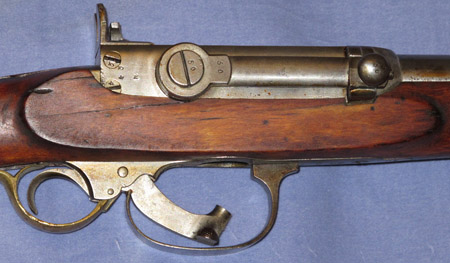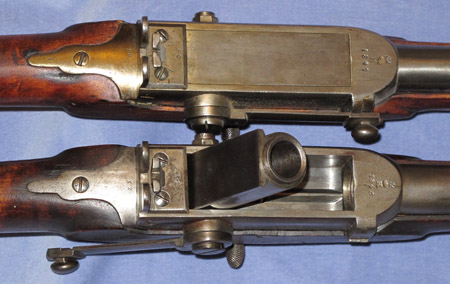M1842 Army Kammerlader
This was to be the first model of Norway’s perhaps second-most famous series of long-gun (only beaten by the Krag Jørgensen) – and by far the most “Norwegian” of all long-guns. In the late 1830s the Norwegian army was looking for a “modern” rifle to introduce as their main long-gun. A lot of foreign rifles were considered, the Danish Løbnitz kammerlader of 1834 was perhaps the most interesting ones, but…
 It was decided to create an advanced breech-loader from scratch. A lot of suggestions and prototypes were tried out and the final rifle as seen above has the best from many of them. A Kongsberg prototype from before the underhammer was chosen, can be seen to the left.
It was decided to create an advanced breech-loader from scratch. A lot of suggestions and prototypes were tried out and the final rifle as seen above has the best from many of them. A Kongsberg prototype from before the underhammer was chosen, can be seen to the left.
The M1842 was produced as a test series with 400 delivered from Kongsberg and 100 delivered from Francotte, Liege. One also wanted to check the domestic quality compared til the Belgium. The M1842 was only approved as a test rifle and was put through extensive trails.
The trails were a great success! The rifle was a great shooter and surpassed any and all earlier models and it was way faster loading. The were a few negative remarks regarding the sights and some other trifling details, the only real issue was the bayonet attachment using the Kyhl’s locking on the socket bayonet. A new locking for the bayonet was designed ![]() and in 1846 499 of the five hundred rifles were split up between Norway’s five garrisons and taken in to service. As a result of the trails, it was decided that an additional 4800 rifles were to be put in to production asap – the M1846. Just about all the M1842s had new rear sights fitted in 1855. In 1859 some of
and in 1846 499 of the five hundred rifles were split up between Norway’s five garrisons and taken in to service. As a result of the trails, it was decided that an additional 4800 rifles were to be put in to production asap – the M1846. Just about all the M1842s had new rear sights fitted in 1855. In 1859 some of  the least worn down M1842s were shortened and converted to M1842/59 and fitted with a saber bayonet. If you look closely at the picture to the right (click on it, it will get lager), you will see a brass screw on the top rifle. Hold your eye there and the rear sights work as a distance measure. This is the M1855 conversion for the new sights.
the least worn down M1842s were shortened and converted to M1842/59 and fitted with a saber bayonet. If you look closely at the picture to the right (click on it, it will get lager), you will see a brass screw on the top rifle. Hold your eye there and the rear sights work as a distance measure. This is the M1855 conversion for the new sights.
The M1842s got to be just about “used up”. They saw almost ten years of heavy service before the army got enough kammerladers and even if they regularly were taken in for refurbishing, most of them were pretty well worn down. A series of 500 rifles is the average naval series size, but the M1842 is way more difficult to find than most navy long-guns. Finding one with the original rear sight behind the chamber is virtually impossible. I don’t have it in its original condition, so the picture on top of the page is a visual correct, but “fully faked version” using photoshop and an naval M1845.
 It may be a bit difficult to see the difference between the M1842 and M1846 versions for the non-expert. the angle of the butt plate is a lot steeper on the M1842 (M1842 at the bottom, M1846 at the top on the picture to the left) and the butt plate is strengthened on the newer model. The brass bands on the M1842 were too thin and would easily bend, they are almost twice as thick on the M1846 and later models – strange this, exactly the same problem was with the M1825, didn’t they learn at Kongsberg? The thumb piece on the hammer is a narrow ridge on the M1842, on the M1846 it is widened and is flat. The M1842 & M1846 have two little crews hold a flat metal plate behind the chamber. This is very easy to see on the ones with the M1855 rear sight. All later army models lack these screws.
It may be a bit difficult to see the difference between the M1842 and M1846 versions for the non-expert. the angle of the butt plate is a lot steeper on the M1842 (M1842 at the bottom, M1846 at the top on the picture to the left) and the butt plate is strengthened on the newer model. The brass bands on the M1842 were too thin and would easily bend, they are almost twice as thick on the M1846 and later models – strange this, exactly the same problem was with the M1825, didn’t they learn at Kongsberg? The thumb piece on the hammer is a narrow ridge on the M1842, on the M1846 it is widened and is flat. The M1842 & M1846 have two little crews hold a flat metal plate behind the chamber. This is very easy to see on the ones with the M1855 rear sight. All later army models lack these screws.
